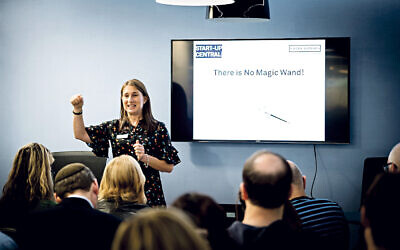Israel’s tale of two cities
Lucy Daltroff discovers the wonders of technology and tradition on a visit to Tel Aviv and Jerusalem
Israel has a fascinating combination of both tradition and innovation – all of which adds an extra layer of interest for tourists.
Certainly on my recent visit, there was a palpable sense of pride around the Beresheet space shuttle, which despite narrowly failing to reach the moon this time around, still represents an amazing achievement for such a small country.
While in Tel Aviv, there was also a call-out for hundreds of volunteers for the Eurovision Song Contest, which will be hosted by the city next weekend.
Get The Jewish News Daily Edition by email and never miss our top stories Free Sign Up
As Ron Huldai, mayor of Tel Aviv, said: “The contest is a once-in-a-generation opportunity to show the beautiful face of Israel to the world – as in surveys, it emerges that one of our main assets is that we are nice, welcoming and warm.”
That may be one of the reasons Israel reported an all-time high in tourist numbers last October of 485,000.
The infrastructure is working hard to keep pace. An underground in Tel Aviv, which at the moment looks like a disorderly collection of building sites, will eventually transform the city.
Add to that the fast train that now runs from Ben Gurion airport to Jerusalem and the more national network of trains that will connect many out-of-town urbanisations.
However the main enthusiasm was reserved for the new Ilan and Assaf Ramon International airport in the Timna Valley in southern Israel, which has just opened.

Currently, in common with other busy cities, trying to find a parking space in Tel Aviv is a bit of a nightmare, so it was impressive witnessing technology in action when visiting my friend‘s modern flat.
When she needs her car, she simply presses a bell in the lobby and can see it on a television screen being selected from the basement parking lot onto a revolving ramp and brought up to ground level outside the front door.
I’m not sure many residences have this level of sophistication, but it presents a fascinating solution to the problem of parking cars on the street.
Away from the technology and innovation, I came across the small but important Hagana Museum in Rothschild Boulevard, which tells the story of the development of the central defence during the British Mandate and the establishment of the state.
Visitors can fully appreciate the tremendous amount of blood, sweat, courage – and even chutzpah – that was necessary. It was difficult to procure planes for the newly-formed air force because of the US Neutrality Act of 1939 forbidding American aircraft being sent to Israel.
Britain also imposed its own embargo. So although Emanuel Zur managed to acquire four war-surplus aircraft, he was blocked from taking them out of the UK.
His creative solution was to set up a bogus motion picture company to make a film about the Second World War. While the cameras rolled, the planes took off, but instead of flying over the movie set, they disappeared from view. It was not until the next day that the British discovered they had arrived in Israel!
On to Jerusalem, where the light railway system, opened in 2011, has completely transformed the centre. Its presence along the main road in itself has eliminated many cars and makes reaching the Old City much easier.
We took it to the very last stop, Mount Hertzl, and then travelled on a short bus ride to Ein Kerem, in the west of the city.
We were enchanted by the beautiful natural groves and the tree-lined landscape of the Jerusalem Hills. With its charming town centre, filled with cafes, restaurants and hotels, Ein Kerem is an ideal place to visit to escape the bustle of town.
Later in the day, we returned to the elegant Waldorf Astoria, which provides the perfect base from which to explore Jerusalem.
It was previously The Palace Hotel, which closed its doors in 1935 and later became the government offices of Israel’s Ministry of Industry and Trade.
Although the building has undergone an extensive revamp, it retains elements of its previous architectural heritage.

On one evening a week, the spectacular, modern lobby is transformed into Shidduch heaven, for the Waldorf is deemed a safe place for young Charedi men and women to meet up, often for the first time – and some with chaperones positioned a safe distance away.
Observing this sight, I couldn’t help but be struck by this very traditional method of dating.
As the milkman Tevye continues to tell us, this “tradition” is still very much a part of Israel’s society – however modern it is in so many other ways.
Lucy stayed at Dan Hotel’s new Link Hotel, Tel Aviv, link-tlv.com, and at the Waldorf Astoria, Jerusalem, waldorfastoria3.hilton.com. She travelled to Stansted Airport with National Express coaches, nationalexpress.com

Thank you for helping to make Jewish News the leading source of news and opinion for the UK Jewish community. Today we're asking for your invaluable help to continue putting our community first in everything we do.
For as little as £5 a month you can help sustain the vital work we do in celebrating and standing up for Jewish life in Britain.
Jewish News holds our community together and keeps us connected. Like a synagogue, it’s where people turn to feel part of something bigger. It also proudly shows the rest of Britain the vibrancy and rich culture of modern Jewish life.
You can make a quick and easy one-off or monthly contribution of £5, £10, £20 or any other sum you’re comfortable with.
100% of your donation will help us continue celebrating our community, in all its dynamic diversity...
Engaging
Being a community platform means so much more than producing a newspaper and website. One of our proudest roles is media partnering with our invaluable charities to amplify the outstanding work they do to help us all.
Celebrating
There’s no shortage of oys in the world but Jewish News takes every opportunity to celebrate the joys too, through projects like Night of Heroes, 40 Under 40 and other compelling countdowns that make the community kvell with pride.
Pioneering
In the first collaboration between media outlets from different faiths, Jewish News worked with British Muslim TV and Church Times to produce a list of young activists leading the way on interfaith understanding.
Campaigning
Royal Mail issued a stamp honouring Holocaust hero Sir Nicholas Winton after a Jewish News campaign attracted more than 100,000 backers. Jewish Newsalso produces special editions of the paper highlighting pressing issues including mental health and Holocaust remembrance.
Easy access
In an age when news is readily accessible, Jewish News provides high-quality content free online and offline, removing any financial barriers to connecting people.
Voice of our community to wider society
The Jewish News team regularly appears on TV, radio and on the pages of the national press to comment on stories about the Jewish community. Easy access to the paper on the streets of London also means Jewish News provides an invaluable window into the community for the country at large.
We hope you agree all this is worth preserving.
-
By Laurent Vaughan - Senior Associate (Bishop & Sewell Solicitors)
-
By Laurent Vaughan - Senior Associate (Bishop & Sewell Solicitors)
-
By Laurent Vaughan - Senior Associate (Bishop & Sewell Solicitors)
-
By Laurent Vaughan - Senior Associate (Bishop & Sewell Solicitors)






















